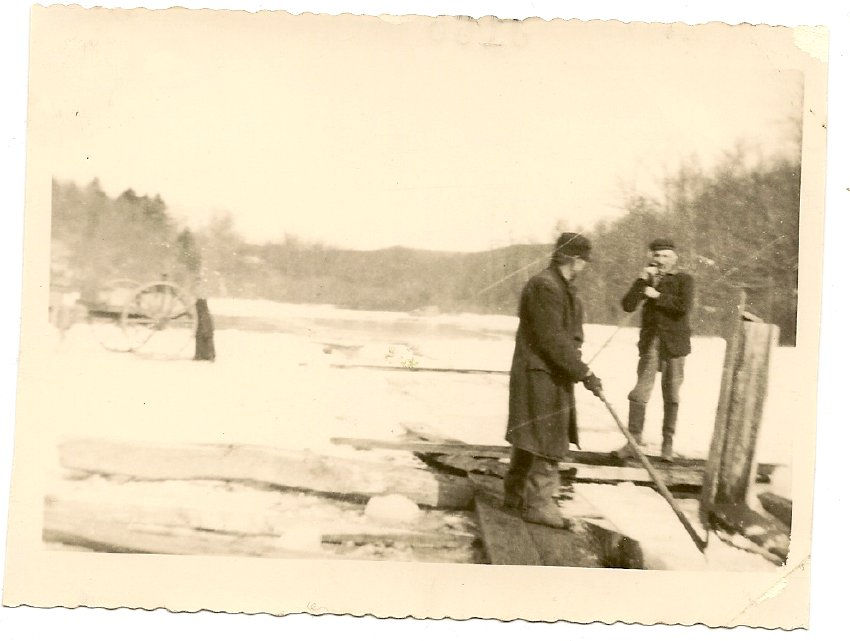Wintertime in East Lyme
- Nicole
- Feb 6, 2021
- 6 min read
Even during the pandemic, people are still eager to get outside and enjoy the staple of New England winter: snow. During the couple of snow days we have had this year, I’ve seen people gear up in their snowsuits, now adding face masks to the ensemble, to sled, ski, or ice skate.
Seeing people partake in wintertime fun got me thinking about what people used to do to make the most of a snow day in East Lyme. Interestingly enough, there may have been even more local options for a snow day activity 50 years ago than there are today.
I spoke to Mrs. Rose Ann Hardy, a longtime History teacher of East Lyme Public Schools and resident of East Lyme who just retired in 2020, and Mrs. Elizabeth Kuchta, East Lyme Town Historian and lifelong resident of East Lyme. They told me stories of everything from an ice skating club, hockey teams, and an ice cutting business; all stories of winters when everyone went outside and helped one another, even on the coldest of days.
Picture this: Gorton Pond in Niantic. An informal ice skating club called the Gorton Lake Figure Eights. Dances held on the frozen lake. Yes, this all actually happened on Gorton Pond, even up until 1970 or so. Nearby houses strung up Christmas lights so that the skaters could dance at nighttime, and neighbors delivered hot chocolate.
Another sight to be seen on East Lyme’s frozen lakes was that of “snowboats” or “iceboats”. These were makeshift, flat-bottomed boats with sails attached that people, especially kids, would take out onto frozen-over bodies of water such as the Niantic River, and race them on the ice.
The idea of these picturesque New England scenes—couples skating with hot chocolate and Christmas lights, and kids making the most of a snow day by playing together with makeshift boats—warmed my heart on a cold, snowy afternoon. We think these things only happen in movies, yet they took place in our own town.
But there’s another story of quaint, community wintertime activities in East Lyme that perhaps takes the cake.
The date was January 15th, 1931, and a deal had been struck. East Lyme at the time had a booming ice business. People would wait for the bodies of water to freeze over, then cut 12 inch slices of ice to sell as far as New York City. With electric refrigerators not invented until 1913, and remaining inaccessible to much of the public for years to come, ice was a “hot” commodity in order to keep food cold. Ice cutting at Clark's Pond next to the Oswegatchie Nature Preserve and Veteran's Field ballparks is pictured below.

On January 15th, people had planned to cut some ice on Tubbs Pond, a now inaccessible section of what we today call Dodge Pond. However, there was a competing interest for the pond’s use on January 15th—hockey players.
Yes, hockey was another popular wintertime activity, even in the 1930s in East Lyme, CT. Local teams formed and played against each other, and the night of January 15th was supposed to be a long awaited big game between Niantic and Old Lyme.
So, the people of East Lyme worked together to come to a compromise. They decided that they would let the hockey players have the big game, and that afterwards the whole town would pitch in to help cut ice and send it out for business.
With excitement in the air, the townspeople decided to make a night of it and call it the Niantic Ice Carnival. To add to the buzz, the Connecticut Light and Power Company had a special surprise.
The CT Light and Power Company was located on Main Street where the police department is now. They sold electric appliances such as stoves, refrigerators, and more. In the year 1931, these appliances had been around for a few decades or so, but we must remember that not every family had them. So the CT Light and Power Company figured that a great way to advertise their high-tech appliances, which were all the rage to those who didn’t have their own, would be to bring the stoves from their showroom to the Niantic Ice Carnival on January 15th and demonstrate by cooking turkeys for all the hockey players and fans.
Now you may ask, how did they set up stoves on a pond? Well, the answer is that they ran a power line down Pennsylvania Avenue, up what we know today as Lakeview Heights, and all the way to the pond.
On an 11 degree night, the whole town showed up to the big game. Niantic won 14-0, and as promised, people pitched in afterwards to cut the ice. The headline that appeared in the Hartford Courant after the event was: “Yum! Yum! Hot Turkey and Coffee for All at Niantic Ice Carnival.”
While hockey, ice skating, and sledding live on, it seems that the throngs of people who used to participate in wintertime activities have gradually retreated into the comfort of their own homes. And for those who are left, they usually have to go out of town to join with other people who share their interests.
For people in my school who are interested in playing hockey, they’ve joined a regional team which practices and plays in arenas towns over from East Lyme.
For those who want to sled, McCooks is still a good spot, but many choose to go to the Old Lyme Country Club, or ditch the sled altogether.
As for ice skating, people have resorted to traveling to places such as the Rosegarden Arena in Norwich. Picking a random body of water in town to skate on isn’t so much a quaint activity anymore as it is a dangerous one: our ponds, lakes, and rivers don’t freeze over as they used to. I can’t help but pin this to the prevalent issue of global warming and climate change, which longtime East Lyme residents agree they have seen firsthand. According to the United States Environmental Protection Agency (EPA), “Connecticut’s climate is changing. The state has warmed two to three degrees (F) in the last century.”
The Yale University Center on Climate Change and Health echoes this message with research from 2020 showing that “Average annual temperature increased by 3.0– 3.5 ºF in each county from 1895 to 2019” and that “the number of frost days (days with minimum temperature at or below 32 ºF) decreased from 1950 to 2018 in four of the eight counties: Middlesex, New London, Tolland, and Windham.” Therefore, it is no surprise that East Lyme residents haven’t seen places such as Dodge Pond or Niantic River, the settings of these fun wintertime stories, freeze over in 15-20 years.
With that being said, there are certainly other factors as to the change in local wintertime activities throughout time. Technology is undoubtedly a big part of the equation. I don’t just mean computers and Internet, but even the early development of radio shows and programs. As entertainment came out that was new, exciting, and accessible to more of the population, it became more tempting and reasonable to stay inside on a cold day rather than go outdoors. As television shows, movies, and yes, eventually laptops and iPhones have grown, life has become more fast-paced. While technology and media has definitely served to connect us all, as we’ve seen during a global pandemic when Zoom became a household name, it has the power to disconnect us if we let it. I find that we become so consumed in it all that we forget to slow down, look outside our window, and enjoy the little things such as a fresh snowfall.
So while there is still snow on the ground, I encourage everyone to embrace the message seen in the old stories of East Lyme’s wintertime activities: get outside, help your neighbors, and don’t take for granted the snow and fresh air—these are signs of a normal winter in New England, which amidst climate change news, is something we should be grateful for.
Whether you decide to dig your sled out of your attic, rummage up your ice skates from the garage, or pitch in to shovel a neighbor’s driveway, perhaps that’s one thing we can take from our history, no matter what changes: the spirit of togetherness.
Works Cited
Bozzi, L. and Dubrow R. (2020). Climate Change and Health in Connecticut: 2020 Report. New Haven, Connecticut, Yale Center on Climate Change and Health.
Hardy, Rose Ann. Telephone interview. 1 Feb. 2021.
Kuchta, Elizabeth Hall. Telephone interview. 1 Feb. 2021. All photographs provided by Mrs. Kuchta.
United States Environmental Protection Agency. "What Climate Change Means for Connecticut." EPA, Aug. 2016, 19january2017snapshot.epa.gov/sites/production/files/2016-09/documents/climate-change-ct.pdf.



Comments